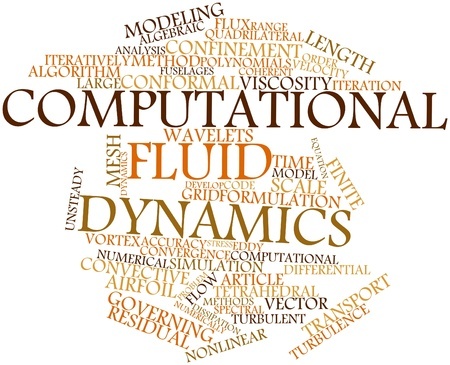
Computational Fluid Dynamics (CFD) is now a well established modelling method for assessing heating regimes, especially in the thermal treatment of food products. It is used with increasing interest in food engineering and over the last ten years, a number of articles are available for consultation (Xia and Sun, 2002; Norton and Sun, 2007). The technique has scored success in its treatment of both liquid and particularly liquid-particulate systems. This is especially where the prediction of transient velocity and temperature profile is required inside containers of all sizes which are being thermally processed. It is now being widely applied to a variety of food stuffs.
The reader is referred to the following examples showing the variety of CFD application:
(1) Assessment of natural convection and bacterial death in canning where the model is an aqueous solution of sodium carboxymethyl cellulose [CMC] (Abdul Ghani et al., 1999a, 1999b) and in pouches (Abdul Ghani et al., 2001).
(2) Determination of heat transfer coefficients during natural convection heating of CMC solutions in cylindrical containers (Kannan and Sandaka 2008),
(3) Real food situations such as pineapple slices in juice (Abdul Ghani and Farid, 2006), peas in water (Kiziltas et al., 2010), asparagus in brine (Dimou and Yanniotis, 2011), and olives in brine (Dimou et al., 2013).
(4) Simulation in liquid and particulate thermal processing, especially large food particles in water (Rabiey et al., 2007),
(5) Spray drying (Gianfrancesco et al., 2010)
(6) Pasteurisation of milk (Anand Paul et al., 2011). Pasteurisation concerns the inactivation of spoilage organisms and enzymes in milk. CFD is used here to examine the temperature distribution pattern inside canned milk when thermally processed. The study predicted that can rotation of 5 rpm was better than a stationary can during pasteurisation.
(7) Pasteurisation of beer (Augusto et al., 2010)
(8) The forming of high-moisture fish noodles (Yu et al., 2024).
This list will grow as more applications are identified.
References
Abdul Ghani, A.G., Farid, M.M. (2006) Using the computational fluid dynamics to analyze the thermal sterilization of solid–liquid food mixture in cans. Innov. Food Sci. Emerg. 7 pp. 55–61.
Abdul Ghani, A.G., Farida, M.M., Chena, X.D., Richards, P. (1999a) Numerical simulation of natural convection heating of canned food by computational fluid dynamics. J. Food Eng. 41(1) pp. 55–64.
____________________________________________ 1999b. An investigation of deactivation of bacteria in a canned liquid food during sterilization using computational fluid dynamics (CFD). J. Food Eng. 42(4) pp. 207–14.
_____________________________________________(2001) Thermal Sterilization of canned food in a 3-D pouch using computational fluid dynamics. J. Food Eng. 48 pp. 147-156
Anandharamakrishnan, C., & Anandharamakrishnan, C. (2013). Computational Fluid Dynamics Applications in Food Processing (pp. 1-9). Springer New York.
Anand Paul, D., Anishaparvin, A., Ananndharamakrishnan, C.(2011) Computational fluid dynamics studies on pasteurisation of canned milk. Int. J. Dairy Technol. 64(2) pp. 305–13
Augusto, P.E.D., Pinheiro, T.F., Marcelo, Cristianini. M. (2010) Using computational fluid-dynamics (CFD) for the evaluation of beer pasteurization: effect of orientation of cans. Ciênc Tecnol Aliment Campinas 30(4) pp. 980–86.
Dimou, A., Yanniotis S. (2011) 3-D numerical simulation of asparagus sterilization using computational fluid dynamic. J Food Eng 104(3) pp. 394–403
__________ Panagou, E., Stoforos, N.G., Yanniotis, S. (2013) Analysis of Thermal Processing of Table Olives Using Computational Fluid Dynamics. J. Food Sci., 78(11) E1695-1703 (Article)
Gianfrancesco, A., Turchiuli, C., Flick, D., Dumoulin, E. (2010) CFD Modeling and Simulation of Maltodextrin Solutions Spray Drying to Control Stickiness. Food Bioprocess. Technol. 3 pp. 946-955
Kannan, A., Gourisankar Sandaka, P.Ch. (2008) Heat transfer analysis of canned food sterilization in a still retort. J. Food Eng. 88 pp. 213–28.
Kiziltas¸ S, Erdogdu F, Palazoglu K. (2010) Simulation of heat transfer for solid–liquid food mixtures in cans and model validation under pasteurization conditions. J Food Eng . 97 pp. 449–56.
Norton, T., Sun, D.W. (2007) An overview of CFD applications in the food industry. In: Sun DW, editor. Computational fluid dynamics in food processing. Boca Raton, Fla.: CRC Press. pp. 1–41.
Park, H. W., & Yoon, W. B. (2018). Computational fluid dynamics (CFD) modelling and application for sterilization of foods: A review. Processes, 6(6), 62.
Xia, B. Sun, D-W. (2002) Applications of computational fluid dynamics (CFD) in the food industry: a review. Computers and Electronics in Agriculture. 34 pp. 5-24
Yu, Y., Tang, M., Hu, W., Ma, L., Feng, X., & Zhang, Y. (2024). Investigations on the forming mechanism of high-moisture extruded fish noodles based on computational fluid dynamics simulation. Journal of Food Engineering, 366, 111856 (Article).


You could do with writing some more about this interesting technology.